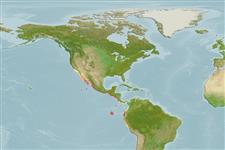Classification / Names
Common names from other countries
Main reference
Size / Weight / Age
Max length : 84.0 cm FL male/unsexed; (Ref. 168); common length : 60.0 cm FL male/unsexed; (Ref. 9340); max. published weight: 9.1 kg (Ref. 168)
Environment
Marine; pelagic-oceanic; oceanodromous (Ref. 51243); depth range 0 - 40 m (Ref. 5227)
Climate / Range
Tropical, preferred 28°C (Ref. 107945); 39°N - 16°S, 128°W - 77°W (Ref. 168)
Distribution
Eastern Pacific: off San Simeon, California, USA southward to the Galapagos Islands and northern Peru. Two stray specimens collected in the Hawaiian Islands.
Countries | FAO areas | Ecosystems | Occurrences | Introductions
Short description
Dorsal
spines
(total): 10 - 15;
Anal
soft rays: 11 - 12;
Vertebrae: 37. Anterior spines of first dorsal fin much higher than those mid-way, giving the fin a strongly concave outline. Interpelvic process small and bifid. Body naked except for corselet and lateral line. Swim bladder absent. A large rounded protuberances on 31st and 32nd vertebrae. Color is generally iridescent blue with black dorsal markings composed of 3 to 5 horizontal stripes. Also with variable black or dark gray spots above the pelvic fins. Occasionally with extensive longitudinal stripes of light gray on belly; some individuals have few or no belly markings.
IUCN Red List Status (Ref. 115185)
Threat to humans
Harmless
Human uses
Fisheries: minor commercial; gamefish: yes
More information
ReferencesAquacultureAquaculture profileStrainsGeneticsAllele frequenciesHeritabilityDiseasesProcessingMass conversion
Tools
Special reports
Download XML
Internet sources
Estimates of some properties based on models
Phylogenetic diversity index
PD50 = 0.6250 many relatives (e.g. carps) 0.5 - 2.0 few relatives (e.g. lungfishes)
Trophic Level
3.8 ±0.60 se; Based on food items.
Resilience
Medium, minimum population doubling time 1.4 - 4.4 years (Assuming tm=2)
Vulnerability
Moderate vulnerability (44 of 100)
Price category
